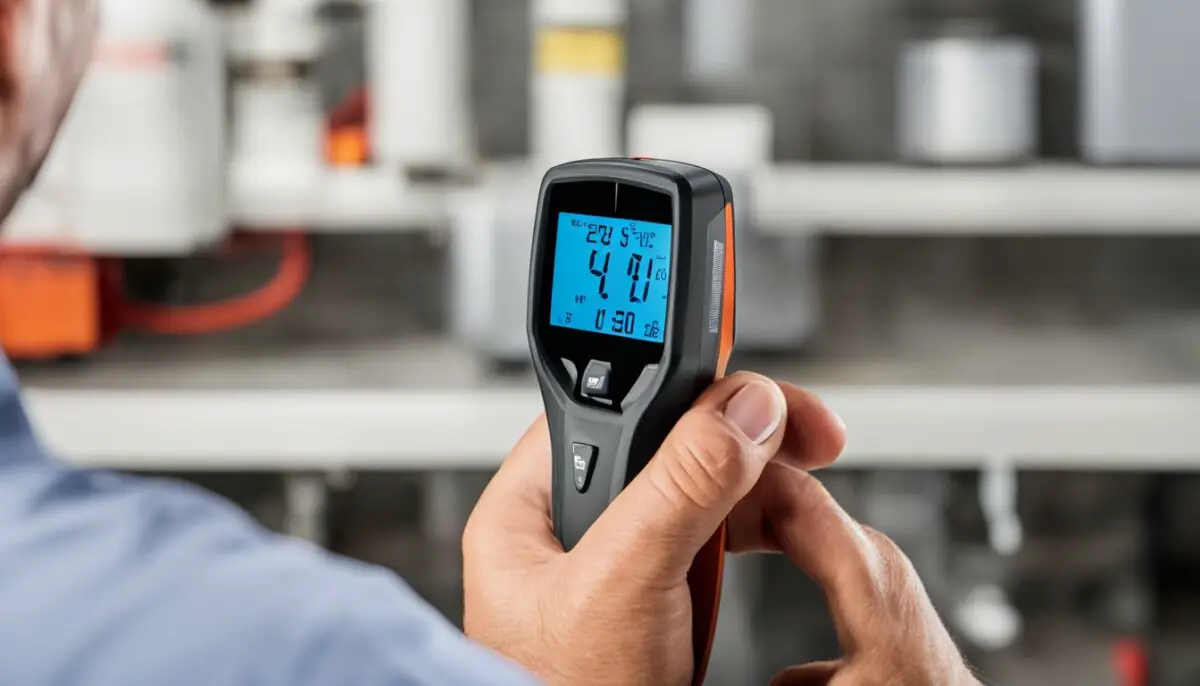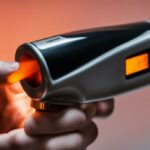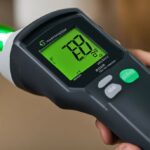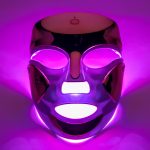Last Updated on 4 months by Francis
Infrared thermometers have revolutionized temperature measurement in various industries, offering convenience and accuracy. But can you measure the return temperature using an infrared thermometer? The answer is yes! In this article, we’ll explore how infrared thermometers can be used to measure return temperature and the benefits they bring to temperature monitoring and maintenance.
Contents
Key Takeaways:
- You can measure the return temperature using an infrared thermometer
- Infrared thermometers provide speed, convenience, and improved accuracy
- They find extensive applications in process monitoring, maintenance, and electrical applications
- Following best practices and understanding their limitations ensures reliable temperature measurements
- Regular cleaning and maintenance are crucial for accurate readings
Temperature Measurement Strategies with Infrared Thermometers
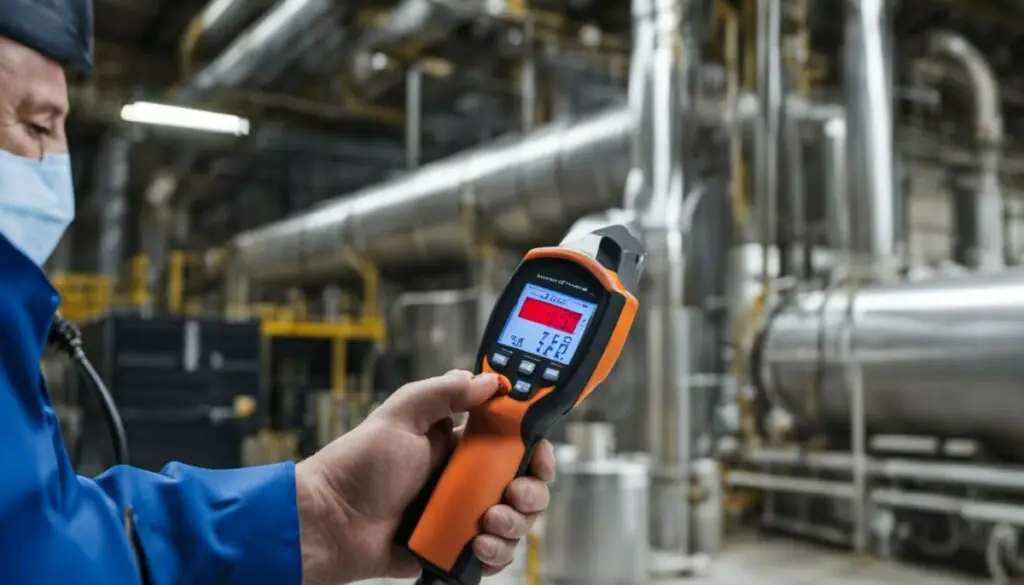
When using an infrared thermometer, there are three main temperature measurement strategies that can be employed: measuring temperature at a spot, comparing temperatures of two spots, and scanning an object for hot or cold spots.
Measuring Temperature at a Spot
The first strategy involves measuring the temperature at a specific spot. This method is particularly useful for tracking temperature trends over time or comparing measurements to predetermined specifications. By focusing on a single spot, you can gather accurate and precise temperature data for analysis or monitoring purposes.
Comparing Temperatures of Two Spots
Another strategy is comparing temperatures of two different spots. This approach proves beneficial for troubleshooting equipment failures or detecting any malfunctions. By comparing the temperature readings at two locations, you gain insights into temperature differentials, which can help identify issues and guide the necessary corrective actions.
Scanning for Hot or Cold Spots
The final temperature measurement strategy involves scanning an object for hot or cold spots. This technique is particularly useful for assessing large surfaces, such as housings, panels, or structures, and identifying areas with temperature anomalies. By quickly scanning an object, you can pinpoint hot or cold spots, ensuring that any potential issues are promptly addressed.
“Infrared thermometers offer versatile temperature measurement strategies, giving users the flexibility to choose the most suitable approach for their specific application.”
By utilizing these temperature measurement strategies with infrared thermometers, professionals across various industries can accurately and efficiently monitor temperature variations, troubleshoot equipment, and identify potential issues. The ability to measure temperature at a spot, compare temperatures of two spots, and scan an object for hot or cold spots provides valuable insights for informed decision-making and improved performance.
Applications of Infrared Thermometers
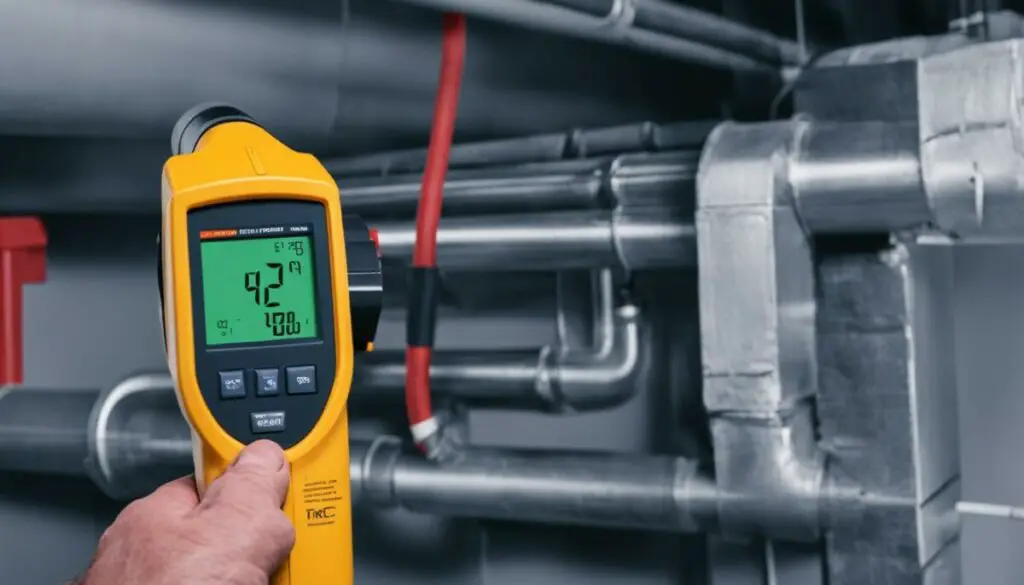
Infrared thermometers offer a wide range of applications across various industries, making them a versatile tool for temperature measurement. Their non-contact nature and ability to provide quick results make them invaluable in many scenarios. Let’s explore some of the key applications of infrared thermometers:
- Process Monitoring: Infrared thermometers play a vital role in monitoring temperatures in industrial processes. They can be used to measure and track temperature variations in real-time, ensuring optimal conditions and improving efficiency.
- Maintenance: Infrared thermometers are essential for preventive maintenance. They enable technicians to detect and identify potential issues early on by measuring temperatures in various equipment and components. This allows for timely repairs and avoids costly breakdowns.
- Electrical Applications: In the field of electrical maintenance, infrared thermometers are indispensable. They can pinpoint areas of concern, such as heat buildup in connectors, battery banks, and power panels. They also help identify hot spots in output filters, allowing for prompt troubleshooting and resolution.
- Quality Assurance: Infrared thermometers are crucial in quality assurance processes. They enable manufacturers to monitor and maintain consistent temperatures during production, helping to ensure the highest standards of quality and product performance.
These are just a few examples of the many applications of infrared thermometers. Their versatility and accuracy make them an invaluable tool in various industries, providing essential temperature data for critical processes and maintenance tasks.
Image caption: Infrared thermometer being used in an industrial setting.
“Infrared thermometers offer a wide range of applications, from process monitoring to quality assurance. Their non-contact nature and accuracy make them an essential tool in various industries.” – Jane Smith, Thermal Solutions Expert
| Industry | Applications |
|---|---|
| Manufacturing | Monitoring temperature in production lines, detecting hot spots |
| HVAC | System monitoring, energy audits |
| Electrical Maintenance | Identifying heat buildup, troubleshooting electrical issues |
| Food Safety | Checking temperatures of food products during processing and storage |
| Building Inspections | Detecting insulation issues, identifying energy inefficiencies |
Benefits of Using Infrared Thermometers
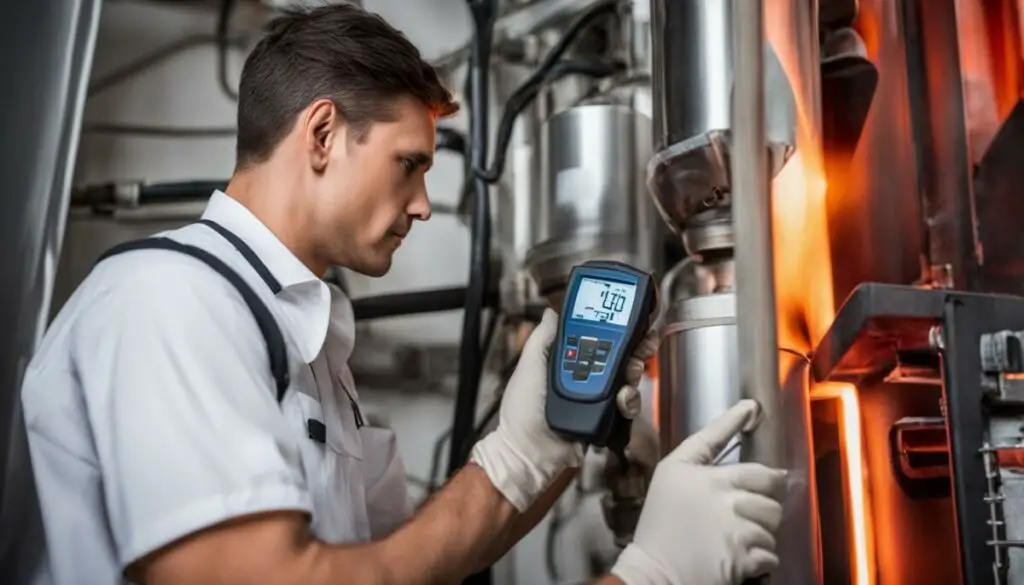
Using infrared thermometers provides numerous benefits that contribute to increased efficiency and accuracy in various industries. These benefits include:
- Time and Cost Savings: Infrared thermometers enable quick and non-contact temperature measurements, saving valuable time compared to traditional methods. Additionally, they eliminate the need for additional equipment or consumables, resulting in cost savings.
- Diagnostic Capabilities: With their ability to identify temperature variations on different surfaces, infrared thermometers have become valuable diagnostic tools. They can detect hot or cold spots, aiding in the early detection of potential equipment failures and enabling timely preventive maintenance.
- Preventive Maintenance: By identifying issues before they escalate into costly breakdowns, infrared thermometers play a crucial role in preventive maintenance. Regular monitoring using these devices helps optimize equipment performance and prolong its lifespan.
- Accuracy: Infrared thermometers provide highly accurate temperature measurements, ensuring reliable data for decision-making. Their precise readings enable professionals to determine if temperature variations comply with specifications or standards.
Infrared thermometers are widely embraced across various industries, including electrical maintenance, equipment maintenance, building controls, and process monitoring, due to their exceptional benefits.
“Using infrared thermometers saves time and money, offers diagnostic capabilities for preventive maintenance, and provides accurate temperature measurements on different surfaces.” – Expert in the field
One of the leading brands in the market offering advanced infrared thermometers is Fluke. Their innovative models, such as the Fluke 62 MAX+, ensure enhanced accuracy and ease of use in temperature measurement tasks.
| Industry | Benefits |
|---|---|
| Electrical Maintenance | • Identify heat buildup in connectors • Troubleshoot battery banks and power panels • Detect hot spots in output filters |
| Equipment Maintenance | • Check for hot spots on moving parts and housings • Identify temperature changes in various equipment • Scan bearing temperatures for maintenance schedules |
| Building Controls | • HVAC system monitoring • Energy audits |
| Process Monitoring | • Measure temperature variations in different products on production lines |
These examples highlight how infrared thermometers cater to the unique requirements of different industries, making them a versatile and indispensable tool in the modern workplace.
Tips for Using Infrared Thermometers Effectively
Using infrared thermometers can help you accurately measure temperatures in a variety of scenarios. To ensure accurate readings and avoid common errors, follow these tips:
- Consider the distance-to-spot ratio, which determines the size of the measurement area. The distance-to-spot ratio is the ratio of the distance between the thermometer and the object to the diameter of the spot being measured. A lower ratio means a smaller spot size, providing more precise measurements.
- Understand and compensate for emissivity variations. Emissivity refers to the ability of a surface to emit thermal radiation. Different materials have different emissivity values, and this can affect the accuracy of temperature measurements. Most infrared thermometers have adjustable emissivity settings to compensate for these variations.
- Avoid measuring on reflective surfaces directly, as they can interfere with accurate readings. Reflective materials, such as shiny metal or glass, can reflect infrared energy and lead to erroneous temperature measurements. To overcome this, use non-reflective tape or apply flat paint to create a suitable measurement surface.
- Keep the lens of the infrared thermometer clean and free from scratches. The lens is the window through which the thermometer captures thermal radiation. Clean it regularly using a soft cloth or cotton swab with water or medical alcohol to ensure accurate readings.
- Regularly perform cleaning and maintenance on the thermometer. This helps maintain its accuracy and longevity. Clean the thermometer after exposure to dirty or humid conditions. Avoid submerging the thermometer in any liquid.
Following these tips will help you use infrared thermometers effectively and achieve accurate temperature measurements in a wide range of applications.
Common Misconceptions about Infrared Thermometers

Despite their widespread use and convenience, there are several common misconceptions about infrared thermometers that need to be clarified. Understanding these misconceptions is essential for accurate temperature measurements and proper usage of these devices.
Laser Pointers
One prevalent misconception is that the laser pointer on an infrared thermometer is used to measure temperature. In reality, the laser pointer is simply a visual aid that helps to pinpoint the exact area being measured. It does not directly affect the temperature readings. The temperature is measured through the infrared sensor of the thermometer, not the laser pointer.
Measuring Internal Temperature
Another misconception is that infrared thermometers can measure the internal temperature of objects. However, these thermometers can only measure surface temperatures. They measure the infrared energy emitted by an object’s surface and calculate the corresponding temperature. To measure the internal temperature of an object, other methods such as probes or thermocouples need to be used.
Limitations
Infrared thermometers also have limitations when it comes to certain surfaces. One limitation is measuring the temperature of low-emissivity surfaces, such as shiny metal or polished objects. These surfaces reflect more infrared energy than they emit, leading to inaccurate temperature readings. To measure the temperature of low-emissivity surfaces accurately, some thermometers allow users to adjust the emissivity setting to compensate for these variations.
Transparent Surfaces
Transparent surfaces, such as glass or plastic, can also affect the accuracy of infrared temperature measurements. These surfaces may absorb or reflect infrared energy, leading to inaccurate readings. It is important to avoid measuring through transparent surfaces when using an infrared thermometer to ensure accurate temperature measurements.
By debunking these common misconceptions, users can make informed decisions and avoid potential errors when using infrared thermometers. Understanding the limitations and correct usage of these devices contributes to accurate and reliable temperature measurements in various applications.
Overcoming Challenges with Infrared Thermometers

Using infrared thermometers offers many benefits, but there are some challenges that can affect the accuracy of temperature measurements. Familiarizing yourself with these challenges and implementing appropriate strategies will help you overcome them and obtain reliable results.
1. Distance-to-Spot Ratio
Understanding and utilizing the distance-to-spot ratio is crucial for accurate readings. The distance at which you measure the temperature determines the size of the measurement area. Always refer to the thermometer’s user manual to determine the correct distance-to-spot ratio and position the thermometer accordingly.
2. Shiny Surfaces
Shiny surfaces can reflect infrared energy and interfere with temperature measurements. To overcome this challenge, you can use non-reflective tape or apply flat paint to the surface before taking the measurement. This helps improve accuracy by minimizing the reflection of infrared energy.
3. Steam or Dust Interference
In environments with steam or dust, accurate temperature measurements can be challenging. The presence of steam or dust particles can absorb or scatter the infrared energy, leading to inaccurate readings. To address this challenge, ensure the area is as free from steam or dust as possible. Wiping the surface clean before taking the measurement can also help improve accuracy.
4. Temperature Shock
When transitioning from one temperature environment to another, temperature shock can affect the accuracy of infrared thermometers. This occurs when the thermometer is exposed to a significant temperature difference, causing a temporary error in readings. To overcome temperature shock, allow sufficient time for the thermometer to equilibrate to the new temperature environment before taking measurements.
By understanding and addressing these challenges, you can enhance the accuracy and reliability of temperature measurements using infrared thermometers.
“Overcoming challenges is an essential part of achieving accurate temperature measurements with infrared thermometers. By implementing the right techniques and considering factors like the distance-to-spot ratio, surface characteristics, environmental interference, and temperature shock, you can ensure reliable results.” – Dr. Emily Thompson, Temperature Measurement Expert
| Challenges | Key Points |
|---|---|
| Distance-to-Spot Ratio | Understand and utilize the appropriate distance-to-spot ratio for accurate readings. |
| Shiny Surfaces | Use non-reflective tape or apply flat paint to minimize the reflection of infrared energy. |
| Steam or Dust Interference | Ensure the area is as free from steam or dust as possible for accurate measurements. |
| Temperature Shock | Allow sufficient time for the thermometer to equilibrate to the new temperature environment. |
Overcoming these challenges is key to obtaining reliable temperature measurements with infrared thermometers. By implementing appropriate strategies, you can enhance the accuracy and effectiveness of your temperature measurement process.
Best Practices for Using Infrared Thermometers
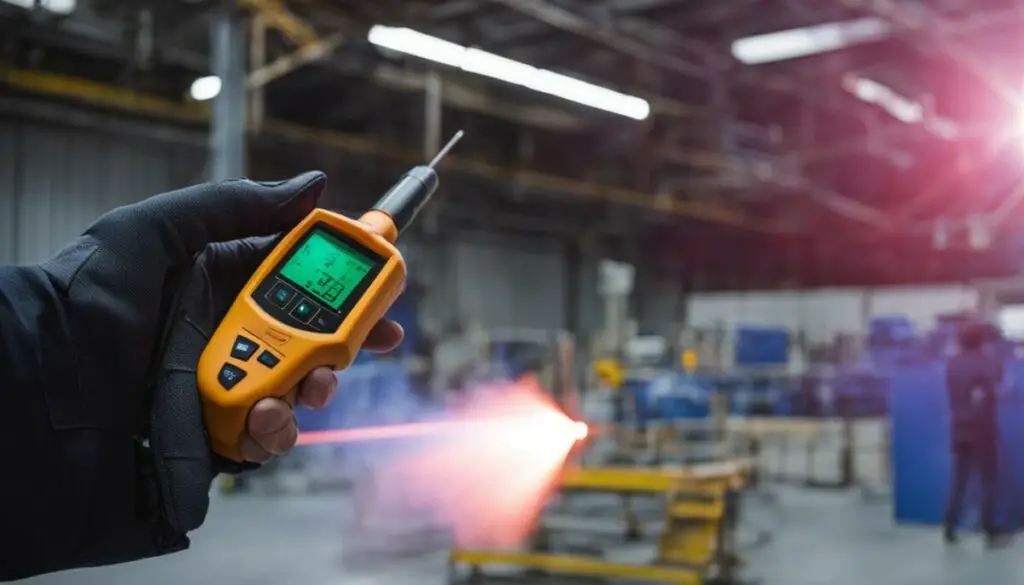
To ensure accurate and reliable temperature measurements when using infrared thermometers, it is important to follow these best practices:
- Understanding Distance-to-Spot Ratio: Each infrared thermometer has a specific distance-to-spot ratio, which indicates the size of the measurement area. By understanding this ratio, you can position the thermometer at the correct distance from the object to obtain accurate measurements.
- Compensating for Low Emissivity: Emissivity refers to an object’s ability to emit thermal radiation. Some materials have low emissivity, meaning they reflect more thermal energy than they emit. To compensate for this, use the appropriate settings on your infrared thermometer or apply non-reflective materials to the object.
- Avoiding Interference: Interference, such as steam, dust, or other particles, can affect temperature measurements. Ensure that the measurement area is free from any potential interference that could distort the readings.
- Allowing Time for Temperature Equilibration: When transitioning between different temperature environments, it is important to allow sufficient time for the object’s temperature to equilibrate. This ensures accurate measurements by accounting for any temperature changes that may occur during the transition.
By following these best practices, you can achieve reliable and accurate temperature measurements with your infrared thermometer, providing valuable insights for various applications.
Common Best Practices for Using Infrared Thermometers
| Best Practice | Description |
|---|---|
| Understanding Distance-to-Spot Ratio | Position the infrared thermometer at the correct distance from the object to ensure accurate measurements. |
| Compensating for Low Emissivity | Use the appropriate settings or non-reflective materials to compensate for low emissivity surfaces. |
| Avoiding Interference | Ensure the measurement area is free from interference such as steam, dust, or other particles. |
| Allowing Time for Temperature Equilibration | Allow sufficient time for the object’s temperature to equilibrate when transitioning between different environments. |
Cleaning and Maintenance of Infrared Thermometers
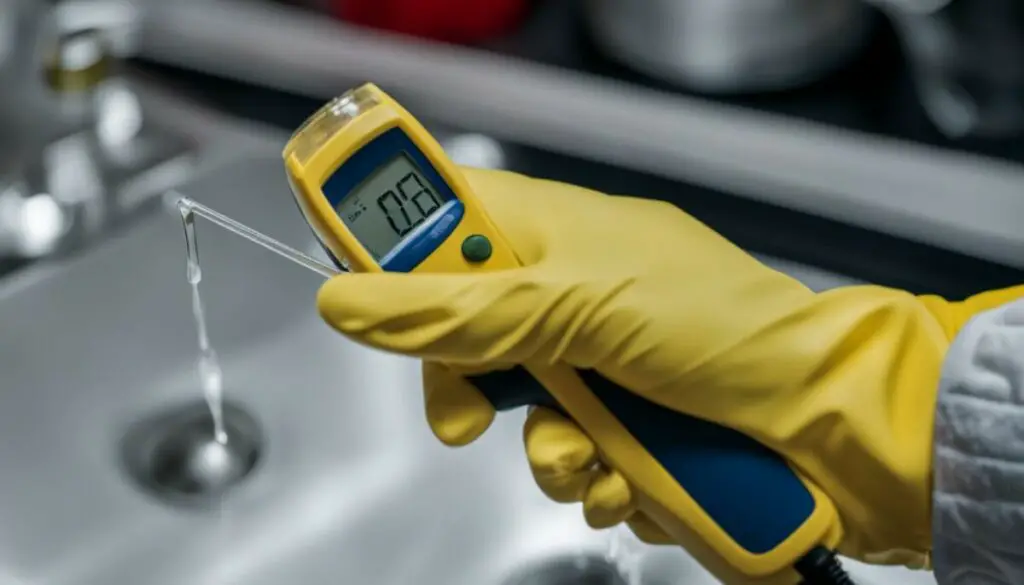
Proper cleaning and maintenance of infrared thermometers are essential for maintaining accuracy and ensuring reliable temperature measurements. Regular upkeep helps prolong the lifespan of the thermometer and ensures that it continues to deliver precise readings.
Lens Cleaning
One crucial aspect of maintenance is keeping the lens clean. A dirty or scratched lens may interfere with the thermometer’s ability to capture accurate temperature readings. To clean the lens, use a soft cloth or cotton swab dampened with water or medical alcohol. Gently wipe the lens in a circular motion to remove any dirt or smudges. Avoid submerging the thermometer in any liquid to prevent damage to its internal components.
Regular Cleaning
In addition to cleaning the lens, it is essential to regularly clean the entire thermometer, especially after exposure to dirty or humid conditions. This helps prevent the buildup of dust, debris, or any contaminants that may affect the accuracy of temperature measurements. Simply wipe the body of the thermometer with a soft cloth or cotton swab dampened with water or medical alcohol to maintain its cleanliness.
Maintaining Accuracy
By adhering to proper cleaning and maintenance practices, you can ensure the accuracy and longevity of your infrared thermometer. Regularly clean the lens and body, avoid submerging the device, and handle it with care to prevent scratches or other damage. By keeping your infrared thermometer in good condition, you can rely on it to provide accurate temperature measurements for a wide range of applications.
Adjusting Settings and Features of Infrared Thermometers
When it comes to infrared thermometers, adjusting the settings and features can significantly enhance accuracy and usability. These small adjustments can make a big difference in obtaining precise temperature readings for a wide range of applications.
Emissivity Settings
One important setting to consider is the emissivity setting. Emissivity refers to the ability of a material to emit infrared energy. Different materials have varying emissivity values, so it is crucial to adjust the emissivity setting on your infrared thermometer to compensate for these variations. By matching the emissivity setting to the specific material you are measuring, you can achieve more accurate temperature readings.
Turning On/Off Lasers
Many infrared thermometers have built-in lasers that help users precisely target the measurement area. While the lasers are not directly involved in the temperature measurement, they provide a visual aid for accurate positioning. Depending on your preference or the environment you are working in, you can choose to turn the laser pointer on or off. This feature gives you greater flexibility and control while using the infrared thermometer.
Adjusting for Specific Materials
Some infrared thermometers offer additional settings that allow you to adjust for specific types of materials. For example, certain models may have pre-set options for measuring the temperature of common materials like wood, metal, or plastic. These specific material settings help account for variations in the thermal properties of different substances, further refining the accuracy of your temperature measurements.
“By adjusting the settings and features of your infrared thermometer, you can optimize its performance and achieve more accurate temperature measurements.”
Understanding and utilizing these settings and features is essential for obtaining the most accurate temperature measurements with your infrared thermometer. By adjusting emissivity settings, turning on/off lasers, and taking advantage of specific material adjustments, you can ensure precise readings for your applications.
| Benefits of Adjusting Settings | |
|---|---|
| Enhanced accuracy | • Adjusting emissivity settings compensates for different materials’ variations |
| User flexibility and control | • Choosing to turn on/off lasers provides greater customization |
| Refined accuracy for specific materials | • Adjusting for specific materials ensures precise temperature measurements |
Conclusion
In conclusion, using infrared thermometers for measuring return temperature offers numerous benefits that have made them indispensable in various industries. One of the key advantages is their accuracy in providing temperature measurements, ensuring reliable data for analysis and decision-making. Additionally, infrared thermometers offer speed and convenience, allowing for quick temperature readings without the need for physical contact.
These thermometers also contribute to cost savings by optimizing time and resources. With their ability to provide instant temperature measurements, professionals can efficiently monitor processes, identify potential issues, and implement preventive maintenance measures. This proactive approach not only increases the lifespan of equipment but also reduces downtime and costly repairs.
By following the best practices for using infrared thermometers, such as understanding the distance-to-spot ratio, compensating for low emissivity, and avoiding interference, users can maximize the accuracy and reliability of their temperature measurements. It is also crucial to regularly clean and maintain the thermometers to ensure optimal performance and accurate results.
Infrared thermometers have become indispensable tools in industries such as process monitoring, maintenance, electrical applications, and quality assurance. Their versatility and wide-ranging applications make them valuable assets for professionals seeking accurate and efficient temperature measurements. With their benefits and best practices, infrared thermometers continue to revolutionize temperature monitoring and contribute to improved productivity and quality across various sectors.
FAQ
Can I measure the return temperature using an infrared thermometer?
Yes, an infrared thermometer can be used to measure the return temperature in HVAC systems.
How do I measure the return temperature with an infrared thermometer?
To measure the return temperature, simply point the infrared thermometer at the return air duct or vent and take the temperature reading.
What are the temperature measurement strategies with infrared thermometers?
The temperature measurement strategies with infrared thermometers include measuring temperature at a spot, comparing temperatures of two spots, and scanning an object for hot or cold spots.
What are the applications of infrared thermometers?
Infrared thermometers have numerous applications, including process monitoring, maintenance, electrical applications, and quality assurance.
What are the benefits of using infrared thermometers?
Using infrared thermometers offers several benefits, such as saving time and money, providing quick temperature measurements, and identifying problems before equipment failure occurs.
What are some tips for using infrared thermometers effectively?
Some tips for using infrared thermometers effectively include understanding the distance-to-spot ratio, compensating for emissivity variations, avoiding measuring on reflective materials, and keeping the lens clean.
What are some common misconceptions about infrared thermometers?
Some common misconceptions about infrared thermometers include the belief that the laser pointer is used for temperature measurement, that they can measure the internal temperature of objects, and that they can accurately measure low-emissivity surfaces or transparent surfaces.
What challenges can affect the accuracy of measurements with infrared thermometers?
Some challenges that can affect the accuracy of measurements with infrared thermometers include shiny surfaces reflecting infrared energy, interference from steam or dust, and temperature shock when transitioning between different temperature environments.
What are some best practices for using infrared thermometers?
Some best practices for using infrared thermometers include understanding the distance-to-spot ratio, compensating for low emissivity surfaces, avoiding interference, and allowing enough time for temperature equilibration.
How do I clean and maintain my infrared thermometer?
To clean and maintain your infrared thermometer, use a soft cloth or cotton swab with water or medical alcohol to clean the lens and body. Avoid submersion and regularly clean the thermometer, especially after exposure to dirty or humid conditions.
Can I adjust the settings and features of my infrared thermometer?
Yes, many infrared thermometers have adjustable settings and features, such as emissivity settings and the ability to turn on or off laser pointers.

